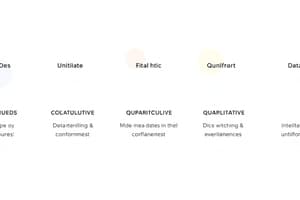Podcast
Questions and Answers
What is a primary method of data collection that provides in-depth information?
What is a primary method of data collection that provides in-depth information?
- Statistical databases
- Public records
- Surveys
- Interviews (correct)
Which of the following is an advantage of secondary data collection?
Which of the following is an advantage of secondary data collection?
- Ensures high accuracy and reliability
- Provides specific data tailored to research questions
- Gathers data directly from participants
- Is typically less time-consuming (correct)
What ethical consideration involves ensuring participants know how their data will be used?
What ethical consideration involves ensuring participants know how their data will be used?
- Accuracy
- Confidentiality
- Consent (correct)
- Privacy
Which tool is commonly used for data collection and can be distributed in various ways?
Which tool is commonly used for data collection and can be distributed in various ways?
Which concept refers to the truthfulness and correctness of collected data?
Which concept refers to the truthfulness and correctness of collected data?
What is a potential drawback of using surveys in data collection?
What is a potential drawback of using surveys in data collection?
What does confidentiality in data collection primarily ensure?
What does confidentiality in data collection primarily ensure?
Which observational tool can help capture behaviors or events during data collection?
Which observational tool can help capture behaviors or events during data collection?
What is the primary purpose of data collection in research?
What is the primary purpose of data collection in research?
Which type of data is primarily focused on characteristics and qualities?
Which type of data is primarily focused on characteristics and qualities?
How can data collection assist organizations in decision-making?
How can data collection assist organizations in decision-making?
What is an example of quantitative data?
What is an example of quantitative data?
Which step does NOT belong in the data collection process?
Which step does NOT belong in the data collection process?
Why is data considered the lifeblood of various sectors today?
Why is data considered the lifeblood of various sectors today?
What should be avoided when analyzing qualitative data?
What should be avoided when analyzing qualitative data?
Which outcome is NOT a benefit of effective data collection?
Which outcome is NOT a benefit of effective data collection?
What is the main purpose of data preprocessing in machine learning?
What is the main purpose of data preprocessing in machine learning?
Which step in the data preprocessing pipeline is focused on correcting errors in data?
Which step in the data preprocessing pipeline is focused on correcting errors in data?
What type of data is characterized by a defined structure, such as databases or spreadsheets?
What type of data is characterized by a defined structure, such as databases or spreadsheets?
Which ethical consideration is essential when collecting data?
Which ethical consideration is essential when collecting data?
What can poor data preprocessing lead to in machine learning models?
What can poor data preprocessing lead to in machine learning models?
What is one of the challenges associated with structured data?
What is one of the challenges associated with structured data?
Which of the following is NOT a reason for performing data preprocessing?
Which of the following is NOT a reason for performing data preprocessing?
Which type of data has some organizational properties but is not fully structured?
Which type of data has some organizational properties but is not fully structured?
Flashcards are hidden until you start studying
Study Notes
Data Collection
- Process of gathering and evaluating information from various sources to answer research questions, evaluate outcomes, and forecast trends.
- Crucial for informed decision-making in nearly every sector.
- Data is the raw information from which statistics are derived, forming the foundation for scientific conclusions.
Data Types
- Qualitative Data: Descriptive and involves characteristics that cannot be counted, expressed in words.
- Examples: Product reviews, customer feedback.
- Quantitative Data: Deals with quantities involving numbers and measurements, analyzed statistically.
- Examples: Fitness tracker data, survey results.
Importance of Data Collection
- Enables informed decision-making.
- Helps validate findings and ensure accuracy in conclusions.
- Critical for monitoring performance and making improvements.
Data Collection Process
- Identify information needed.
- Choose a data collection method.
- Analyze the collected data.
- Present the findings.
Primary Data Collection
- Gathering new data directly from the source.
- Examples: Interviews, surveys, and observations.
- Provides in-depth information but may not be feasible for large numbers (interviews).
- Surveys are efficient and cost-effective, but response rate and design can affect data quality.
- Observation provides rich data but requires careful planning.
Secondary Data Collection
- Using data already collected for other purposes.
- Examples: Public records, statistical databases, research articles.
- Can be less time-consuming and less expensive than primary data collection.
- May not be as specific or tailored to the research question.
- Issues with accuracy and reliability may arise.
Tools for Data Collection
- Questionnaires: Common tool distributed in person, through mail, or electronically. Flexible, cost-effective, and can collect data from a large number of participants simultaneously.
- Observational Tools: Include video and audio recording devices for capturing behaviors or events; software for tracking online behavior and conducting structured observations (checklists or rating scales).
Ethics in Data Collection
- Privacy: Respecting individuals' rights to control information about themselves. Data collection should not intrude unnecessarily into their lives.
- Consent: Participants have the right to know how their data will be used and to agree to this use. Consent should be informed.
- Confidentiality: Data should be stored securely and access should be restricted to those who need it for legitimate purposes.
- Accuracy: Striving for truthfulness and correctness of the data. This includes careful design, training, and error checking.
Introduction to Data Preprocessing
- Transforming raw data into a clean and usable format.
- Critical step before applying machine learning models to ensure optimal model performance.
- Poor preprocessing can lead to inaccurate models and misleading insights.
Importance of Data Preprocessing
- Improves data quality by handling missing values, outliers, and inconsistencies.
- Ensures better performance of machine learning algorithms.
- Helps prevent bias and errors in modelling.
- Saves time and resources by reducing computational complexity.
Data Preprocessing Pipeline
- Data Cleaning: Handling missing data, outliers, and duplicates.
- Data Transformation: Feature scaling, encoding categorical variables.
- Data Reduction: Dimensionality reduction, feature selection.
- Data Integration: Merging datasets, resolving schema discrepancies.
Data Preprocessing in Machine Learning
- Ensures the data is ready for algorithms by normalizing and encoding it.
- Reduces noise and irrelevant features for better model accuracy.
- Handles class imbalances, improving model performance.
Types of Data and Their Challenges
- Structured Data: Organised in a defined manner (e.g., databases, spreadsheets).
- Unstructured Data: Data without a predefined format (e.g., text, images, videos).
- Semi-structured Data: Data that is not fully structured but has some organizational properties (e.g., JSON, XML).
Challenges with Structured Data
- Missing Values: Incomplete records can lead to inaccurate analysis.
- Outliers: Extreme values can distort statistical models.
- Duplicates: Multiple occurrences of the same record can bias results.
Studying That Suits You
Use AI to generate personalized quizzes and flashcards to suit your learning preferences.




